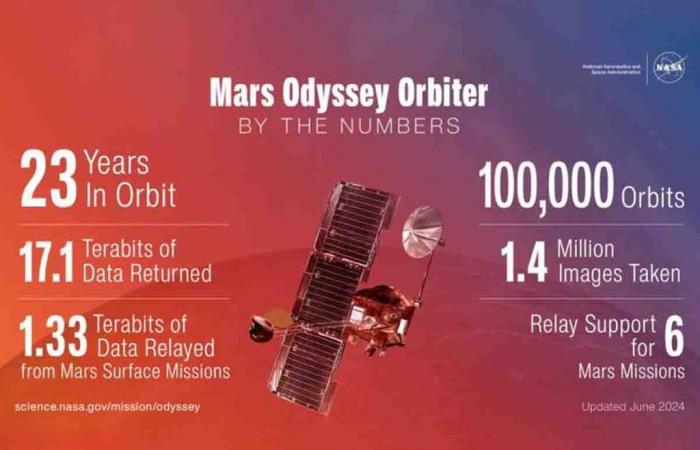Il Mars Odyssey from the NASAthe longest-lived robot in orbit around Marte, will reach a new milestone on June 30, 2024: 100,000 orbits around the Red Planet since its launch 23 years ago. During this time, the 2001 Mars Odyssey orbiter mapped minerals and ice on the Martian surface, identified landing sites for future missions, and transmitted data to Earth from NASA rovers and landers.
Recently, scientists used the orbiter’s camera to take a stunning new image of Olympus Mons, the tallest volcano in the solar system. This image is part of an ongoing effort by the Odyssey team to provide high-altitude views of the Martian horizon. The first of these views was released in late 2023. Similar to the perspective astronauts have of Earth aboard the International Space Station, this view allows scientists to gain insight into the clouds and suspended dust on Mars.
Taken on March 11, the most recent skyline image captures Olympus Mons in all its majesty. With a base spanning 600 kilometers and a height of 27 kilometers, the shield volcano is impressive in both its size and scientific importance.
NASA’s 2001 Mars Odyssey mission captured this image of Olympus Mons on March 11, 2024. In addition to providing an unprecedented view of the volcano, the image helps scientists study different layers of material in the atmosphere, including clouds and dust, as explained by Jeffrey PlautOdyssey Project Scientist at NASA’s Jet Propulsion Laboratory in California:
We normally see Olympus Mons in narrow segments from above, but by turning the spacecraft toward the horizon we can see in a single image just how imposing it is on the landscape. The image is not only spectacular, but also provides us with unique scientific data.
In addition to providing a snapshot of clouds and dust, such images, when taken at different seasons, can give scientists a more detailed understanding of the Martian atmosphere. A bluish-white band at the base of the atmosphere suggests how much dust is present there during early autumn, when dust storms typically begin. The purple layer above it is likely a mixture of the planet’s red dust with some bluish water ice clouds. Finally, toward the top of the image, a blue-green layer can be seen where the water ice clouds reach about 50 kilometers into the sky.
The technique behind the image
Laura Kerber, deputy project scientist for NASA’s Mars Odyssey orbiter, explains how and why the spacecraft in May 2023 captured a view of the Red Planet similar to that of the International Space Station on Earth. The orbiter, named after Arthur C. Clarke’s classic science fiction novel “2001: A Space Odyssey,” captured the scene with a heat-sensitive camera called Thermal Emission Imaging System, or THEMIS, built and operated by the University of Arizona in Tempe. But since the camera is designed to look straight down, getting a photo of the horizon requires extra planning.
What is Odyssey’s secret to being the longest active mission orbiting a planet other than Earth? He answered this question Steve SandersProject Odyssey space operations engineer at Lockheed Martin Space in Denver:
Physics does much of the hard work for us, but it’s the subtleties that we have to deal with over and over again. These variables include fuel, solar energy, and temperature. To ensure that Odyssey uses its fuel (hydrazine gas) sparingly, engineers must calculate how much is left since the spacecraft doesn’t have a fuel gauge.
Odyssey relies on solar energy to run its instruments and electronics. This power varies as the spacecraft disappears behind Mars for about 15 minutes per orbit. And temperatures must remain balanced for all of Odyssey’s instruments to function properly. Joseph HuntJPL’s Odyssey Project Manager, commented:
It takes careful monitoring to keep a mission going for this long while maintaining a historic history of science planning and execution, as well as innovative engineering practices. We look forward to collecting many more great science data in the years to come.





